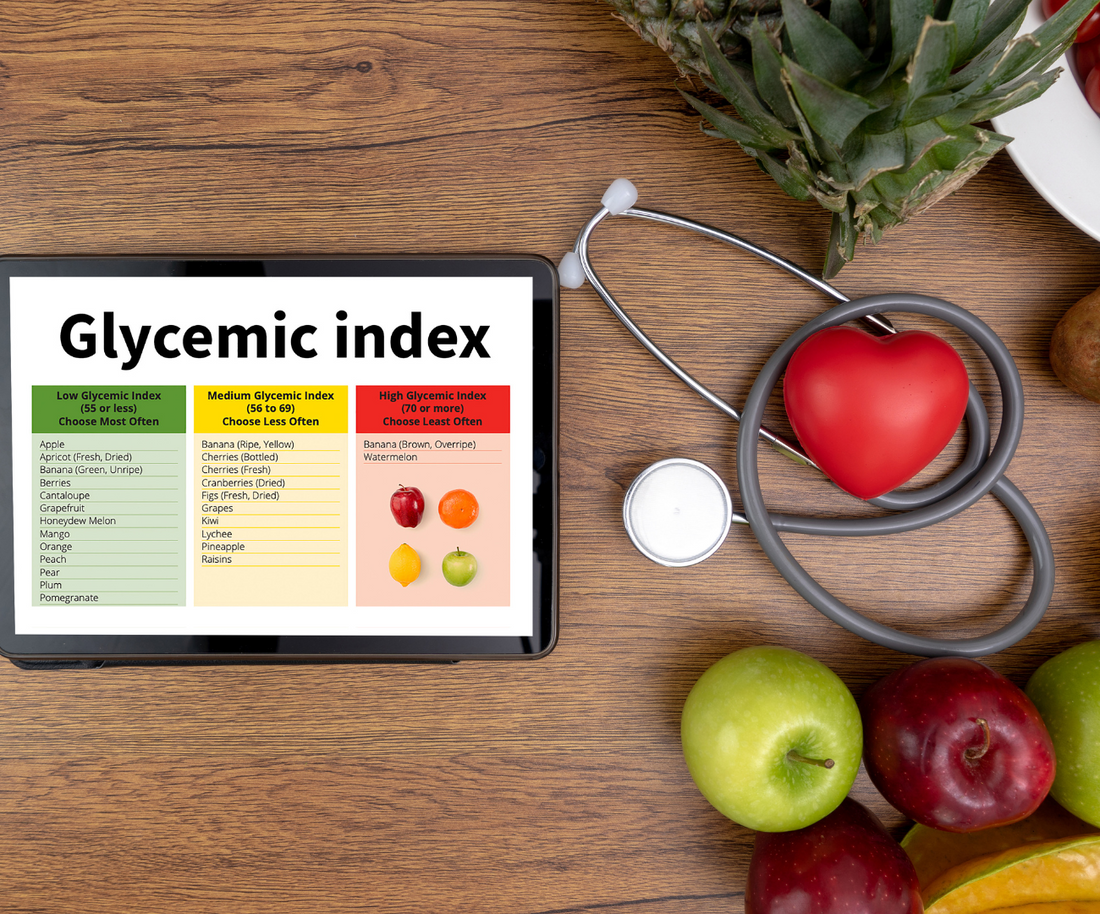Good glycemic control is essential for people with diabetes, as well as those who are at risk for developing the condition.
Maintaining healthy blood sugar levels can help prevent a range of complications associated with diabetes, such as nerve damage, heart disease, and blindness.
While medications can help manage blood sugar levels, lifestyle changes such as diet and exercise are equally important.
This article will explore seven tips for maintaining good glycemic control, including dietary recommendations, exercise, and monitoring blood sugar levels.
By following these tips regarding glycemic control, you can take an active role in managing your blood sugar levels and maintaining your overall health and well-being.
What Is The Glycemic Index Food Chart?

The glycemic index (GI) is a measure of how quickly foods containing carbohydrates raise blood sugar levels after consumption.
The GI is measured on a scale of 0 to 100, with higher scores indicating that food will cause a more rapid increase in blood sugar levels.
The glycemic index food chart is a tool that lists various foods and their corresponding GI values.
It can be used by people with diabetes, as well as those who are interested in maintaining healthy blood sugar levels.
Foods with a low GI score are generally considered to be healthier, as they cause a slower and more gradual increase in blood sugar levels, which helps to avoid spikes and crashes in blood sugar levels.
Some examples of low-GI foods include whole grains, legumes, fruits and vegetables, and some dairy products.
High GI foods, on the other hand, include refined carbohydrates, such as white bread and pasta, sugary snacks, and some types of fruit, such as watermelon and pineapple.
While the glycemic index food chart can be a helpful tool for managing blood sugar levels, it is important to note that the GI of a food can be affected by a variety of factors, such as how it is cooked and what other foods it is eaten with.
Therefore, it is best to use the food chart as a general guide and to work with a healthcare provider or nutritionist to develop a personalized diet plan.
Benefits Of Diabetes Management Guidelines

The benefits of diabetes management guidelines are numerous, both for individuals living with diabetes and for healthcare providers.
Here are some of the key benefits:
1. Improved Blood Sugar Control
These guidelines provide evidence-based recommendations for achieving and maintaining healthy blood sugar levels.
By following these guidelines, individuals with diabetes can reduce their risk of complications such as nerve damage, heart disease, and blindness.
2. Personalized Treatment Plans
These guidelines take into account factors such as age, gender, and other medical conditions, to provide personalized treatment plans that are tailored to each individual's needs.
This can help ensure that individuals receive the right treatment at the right time, and can improve their overall health outcomes.
3. Better Communication Between Patients And Healthcare Providers
These guidelines can help facilitate better communication between patients and healthcare providers, as they provide a common language and framework for discussing diabetes management strategies.
4. More Efficient Use Of Healthcare Resources
By following these guidelines, healthcare providers can make more efficient use of healthcare resources, such as medications and testing supplies.
This can help reduce healthcare costs and improve overall healthcare outcomes.
5. Improved Quality Of Life
By achieving and maintaining healthy blood sugar levels, individuals with diabetes can experience improved quality of life, with fewer complications and a reduced risk of long-term health problems.
In summary, diabetes management guidelines provide evidence-based recommendations for achieving and maintaining healthy blood sugar levels and can lead to improved health outcomes, better communication between patients and healthcare providers, more efficient use of healthcare resources, and improved quality of life.
7 Glycemic Control Tips

Here are seven tips for maintaining good glycemic control:
1. Monitor Your Blood Sugar Levels Regularly
Checking your blood sugar levels regularly can help you understand how your body responds to different foods, activities, and medications.
Your healthcare provider can help you determine how often you should check your blood sugar levels and what target range you should aim for.
2. Follow A Healthy Diet
Eating a diet that is high in fiber and low in refined carbohydrates can help you maintain healthy blood sugar levels.
Focus on eating whole grains, fruits, vegetables, and lean protein sources.
Cutting down on sugar intake and replacing it with zero-calorie sweeteners like Bonvia stevia is a good strategy for managing blood sugar levels, particularly for individuals with diabetes or those at risk for developing the condition.
3. Exercise Regularly
Exercise can help improve insulin sensitivity and promote healthy blood sugar levels.
Aim for at least 150 minutes of moderate-intensity exercise per week, such as brisk walking, cycling, or swimming.
4. Take Your Medications As Prescribed
If you take medication to manage your blood sugar levels, make sure you take it as prescribed by your healthcare provider.
5. Manage Stress
Stress can cause blood sugar levels to rise, so it's important to find ways to manage stress, such as practicing relaxation techniques or engaging in regular physical activity.
6. Get Enough Sleep
Lack of sleep can also cause blood sugar levels to rise, so it's important to get enough sleep each night.
Aim for at least 7-8 hours of sleep per night.
7. Work With Your Healthcare Provider
Your healthcare provider can help you develop a personalized diabetes management plan that takes into account your individual needs and goals.
Work with your healthcare provider to determine the best course of action for managing your blood sugar levels.
Try Bonvia Stevia Zero Calorie Sweetener
Bonvia stevia is a zero-calorie sweetener made from the leaves of the Stevia rebaudiana plant, which is native to South America.
Stevia has been used for centuries as a natural sweetener, and it has gained popularity in recent years as a sugar alternative due to its zero-calorie content and low glycemic index.
1. Zero Calories
Using Bonvia stevia as a sugar substitute can be beneficial for individuals who are looking to manage their blood sugar levels, lose weight, or reduce their overall calorie intake.
Unlike sugar, which contains 16 calories per teaspoon, Bonvia stevia contains no calories, making it an ideal choice for those who are trying to reduce their calorie intake.
2. Low Glycemic Index
Bonvia stevia is also a good option for individuals with diabetes or those at risk of developing the condition.
Stevia has been found to have a low glycemic index, which means it does not significantly raise blood sugar levels.
This can help individuals with diabetes maintain better control of their blood sugar levels, and reduce the risk of complications associated with the condition.
3. Simple And Convenient
Using Bonvia stevia is also simple and convenient.
It can be used in place of sugar in a variety of foods and beverages, including coffee, tea, fruity desserts, and smoothies.
It can also be used in cooking and baking, as it is heat-stable and does not break down at high temperatures.
In conclusion, using Bonvia stevia as a sugar substitute can be a good strategy for managing blood sugar levels and reducing overall calorie intake.
It is a safe and convenient alternative to sugar and can be used in a variety of foods and beverages.
Try Bonvia today and find out for yourself.
Final Thoughts
In conclusion, maintaining good glycemic control is an important part of managing diabetes and reducing the risk of complications associated with the condition.
By following the seven tips outlined in this guide, individuals can better manage their blood sugar levels and improve their overall health and well-being.
Regular monitoring of blood sugar levels, following a healthy diet, exercising regularly, taking medication as prescribed, managing stress, getting enough sleep, and working with a healthcare provider are all essential components of maintaining good glycemic control.
In addition, individuals can consider using sugar alternatives like Bonvia stevia to reduce their sugar intake and maintain healthy blood sugar levels.
However, it is important to remember that sweeteners should be used in moderation and as part of a balanced diet.
By incorporating these tips into their daily routine, individuals with diabetes or those at risk of developing the condition can take control of their health and prevent complications associated with high blood sugar levels.
FAQs
1. What are fruits with low glycemic index?
Fruits with low glycemic index are those that are less likely to cause a significant increase in blood sugar levels when consumed.
Some examples of fruits with a low glycemic index include cherries, apples, pears, berries, grapefruit, oranges, and peaches.
These fruits are rich in fiber, which helps to slow down the absorption of sugar into the bloodstream, and they are also packed with vitamins, minerals, and antioxidants that are beneficial for overall health.
Incorporating fruits with low glycemic index into a balanced diet can be a good strategy for individuals looking to manage their blood sugar levels and maintain good glycemic control.
2. What are the 7 steps to control diabetes?
Controlling diabetes requires a comprehensive approach that involves multiple strategies.
The seven steps to control diabetes include monitoring blood sugar levels regularly, following a healthy diet, getting regular exercise, taking medication as prescribed, managing stress, getting enough sleep, and working closely with a healthcare provider.
By incorporating these steps into their daily routine, individuals with diabetes can improve their blood sugar control, reduce their risk of complications, and maintain better overall health and well-being.

